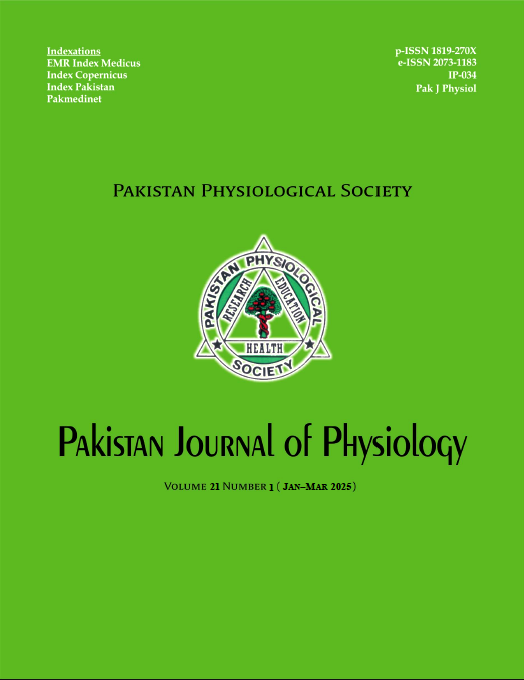FREQUENCY OF METABOLIC SYNDROME IN PATIENTS WITH FEMALE PATTERN HAIR LOSS
DOI:
https://doi.org/10.69656/pjp.v21i1.1767Keywords:
Androgenetic Alopecia, Female Pattern Hair Loss, Metabolic SyndromeAbstract
Background: Female androgenetic alopecia is a common cause of non-scarring alopecia in women. There is strong pathogenetic link between metabolic syndrome (MetS) and androgenetic alopecia in men. The available evidence on the frequency of metabolic syndrome in women with androgenetic alopecia is limited while there is no local published material which necessitated the present study. Methods: It was a hospital based cross-sectional study conducted at Dermatology Department, Jinnah Hospital, Lahore, from 1st Jan to 30th Jun 2023. Ninety-six women aged 19–45 years fulfilling the inclusion criteria were evaluated for metabolic syndrome. The frequency of metabolic syndrome was noted and compared across various subgroups based on patient’s age, duration of disease and pattern of hair loss. Results: The mean age of the patients was 29.2±7.2 years, 66.7% of the women were aged 30 years while 33.3% were above 30 years. The mean duration of disease was 2.6±1.2 years; it was 3 years in 70 (72.9%) women, more than 3 years in 26 (27.1%). Forty-two (43.8%) women had Christmas tree pattern, 32 (33.3%) had diffuse central thinning and 22 (22.9%) had fronto-temporal recession. Metabolic syndrome was diagnosed in 57 (59.4%) women with female pattern hair loss (FPHL). When stratified, there was no statistically significant difference in the frequency of metabolic syndrome across various subgroups. Conclusion: A substantial proportion of patients with female pattern hair loss suffered from metabolic syndrome.
Pak J Physiol 2025;21(1):14–6, DOI: https://doi.org/10.69656/pjp.v21i1.1767
Downloads
References
Griffiths CEM Baker J, Bleiker TO, (Eds). Rook’s Textbook of Dermatology. 10th ed. Vol. 3. New Jersey: ?Wiley-Blackwell; 2024.
Müller Ramos P, Melo DF, Radwanski H, de Almeida RFC, Miot HA. Female pattern hair loss: therapeutic update. An Bras Dermatol 2023;98(4):506–19.
Almudimeegh AM, Alekrish KA, Bahammam RA, Alhedaithi IA, Al Dakheel KA. The association between androgenic alopecia severity and the development of metabolic syndrome in Saudi Arabia: A case-control study. J Dermatol Dermatol Surg 2021;25(2):70–5.
Singh S, Makhecha MB. A cross-sectional, observational study of the clinico-epidemiological profile of female pattern hair loss in Western India and its association with metabolic syndrome. Indian Dermatol Online J 2023;14(2):226–31.
El Sayed MH, Abdallah MA, Aly DG, Khater NH. Association of metabolic syndrome with female pattern hair loss in women: a case-control study. Int J Dermatol 2016;55(10):1131–7.
Sheikh FZ, Butt G, Hafeez R, Maqsood A, Altaf F, Hussain I. Association of early-onset androgenetic alopecia and metabolic syndrome. J Coll Physicians Surg Pak 2021;31(2):123–7.
El-Zeftawy HM, Gaber MA. Association of metabolic syndrome and female pattern hair loss. Menoufia Med J 2021;34(2):446–50.
Chen S, Xie X, Zhang G, Zhang Y. Comorbidities in androgenetic alopecia: A comprehensive review. Dermatol Ther 2022;12(10):2233–47.
Özkoca D, A?k?n Ö, Engin B. The comparison of demographics and comorbidities of female pattern hair loss according to the clinical subtype and stage. J Am Acad Dermatol 2021;84(4):779–83.
Ohn J, Son HY, Yu DA, Kim MS, Kwon S, Park WS, et al. Early onset female pattern hair loss: A case-control study for analyzing clinical features and genetic variants. J Dermatol Sci 2022;106(1):21–8.
Tandon S, Arora P, Gautam RK, Bhardwaj M, Garga U, Sharma N. Correlation between clinical features, biochemical parameters, and histopathological findings in women with patterned baldness: A study from North India. J Cutan Aesthet Surg 2019;12(1):42–8.
Mansuri UU, Vaaruni R, Parmar KS, Shah BJ. A comparative study of treatment modalities in female androgenetic alopecia. Int J Res Med Sci 2016;4(4):1229–36.
Verma D, Vibhu V, Garg T, Tripathi S, Tomer S. Assessment of cardiovascular risk factors in women having female pattern hair loss. Indian J Dermatol 2024;69(1):7–15.
Zhu H, Guo H, Gao Y, Wei Y, Mao T, Yang J. A community-oriented survey on the association between androgenetic alopecia and metabolic syndrome in Chinese people. Front Med 2022;9:100958.
Downloads
Published
How to Cite
Issue
Section
License
Copyright (c) 2025 Aamna Naeem, Sadaf Fasih, Rabia Mukhtar, Muhammad Waseem Anwar, Muneeza Qamar, Sehrish Khalid

This work is licensed under a Creative Commons Attribution-NoDerivatives 4.0 International License.
The author(s) retain the copyrights and allow their publication in Pakistan Journal of Physiology, Pak J Physiol, PJP to be FREE for research and academic purposes. It can be downloaded and stored, printed, presented, projected, cited and quoted with full reference of, and acknowledgement to the author(s) and the PJP. The contents are published with an international CC-BY-ND-4.0 License.











